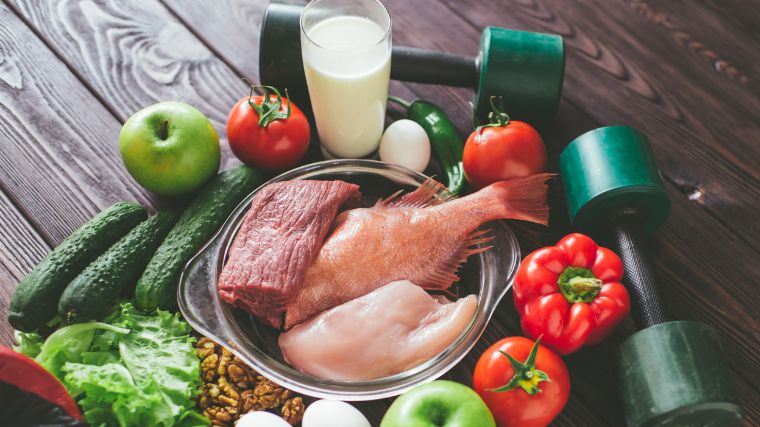If you follow fitness, bulking and cutting may seem like all the rage. Many athletes and fitness enthusiasts aim for the singular goal of fat loss or muscle gain, alternating between the two to gradually change their body compositions and physiques over time. It works, sure, but these processes take time and often involve “making up” for lost muscle or unwanted fat gained.
But who says you can’t accomplish both muscle gain and fat loss simultaneously? Are the laws of thermodynamics immutable and inarguable? As it turns out, there’s a bit more nuance behind so-called body recomposition than you might think.

In the past, body recomposition was believed to be impossible due to the very different energy needs – a calorie deficit for fat loss versus extra calories for muscle gain – but plenty of recent research shows that this isn’t just a possibility. In fact, it’s actually fairly common.
Editor’s Note: The content on BarBend is meant to be informative in nature, but it should not be taken as medical advice. When starting a new training regimen and/or diet, it is always a good idea to consult with a trusted medical professional. We are not a medical resource. The opinions and articles on this site are not intended for use as diagnosis, prevention, and/or treatment of health problems. They are not substitutes for consulting a qualified medical professional.
What Is Body Recomposition?
First, let’s start by explaining body composition, which refers to the balance of lean mass and fat mass that make up a person’s body weight. For example, a person might weigh 150 pounds and have 22 percent body fat, which means they have 117 pounds of lean mass and 33 pounds of fat mass.
[Read More: The Best Online Workout Programs For Coaching, Cardio, Value, And More]
Not all lean mass is muscle, though; lean mass also includes the weight of bones, tendons, connective tissue, and body water. Body recomposition refers to simultaneously losing fat and building muscle, while maintaining a fairly stable body weight. (1) Note that body recomposition doesn’t involve converting fat into muscle or vice-versa.
How to Achieve Body Recomposition
Body recomposition requires both fat loss and muscle gain, which, on paper at least, means you’ll need both a deficit and an excess of calories. You can’t eat more and less at the same time, though. Here’s what’s going on under the hood:
Understand Energy Balance
Remember that your body stores a lot of calories (or energy) in the form of fat, which it breaks down when you burn more calories than you take in and need extra energy to fuel your activity and bodily processes.
On the other hand, when your calorie intake exceeds your expenditure, you do store that energy as fat, but that’s not the only outcome. An energy surplus can also be used to build muscle, provided you’re hitting the gym and performing resistance training. (1)(2)
To put it into simpler terms, your body needs two things to build new muscle tissue: the raw materials (protein, amino acids, and so on) and the energy to fuel the muscle-building process. That energy can come from breaking down the protein, carbs, and fats in your diet, or by breaking down (or burning) existing body fat.

[Read More: Nutrition for Athletes — How to Eat for Muscle and Performance]
Also, the number of calories you need to build a pound of muscle is much less than you need to build a pound of fat. Just like the proteins and fats in your diet, your muscles are about half as energy-dense as your body fat.
Here’s the bottom line: The fact that your body stores energy in the form of fat means you have some wiggle room when it comes to the amount of energy you need from your diet.
Eat Enough Protein
On a molecular level, protein and fat have a lot in common. They’re both made of carbon, hydrogen, and oxygen, but protein has an extra ingredient: nitrogen. So, although your body fat can be broken down for energy to power hypertrophy, it can’t provide all of the necessary ingredients.
That’s why it’s important to eat a high protein diet if you’re aiming for recomposition. You still need enough of the raw materials to build muscle mass. Aim to eat 2.6 to 3.5 grams of protein per kilogram of bodyweight daily. It might be tough to meet that goal without adding a protein powder, but the good news is that protein shakes are just as effective as whole-food sources. (1)(2)(3)(4)
Eat Enough Calories (but Not Too Many)
If you’re meeting your daily calorie needs with a high protein diet — and therefore maintaining your body weight — you’re likely to achieve body recomposition. Body recomposition is dramatically less practical in a calorie deficit, though. (1)(2)(3)(4)
[Read More: The Best Foods for Energy Before, During, and After Your Workouts]
The bigger your calorie deficit, the less likely you are to gain muscle mass. If you want to maximize your chances, don’t exceed a 500-calorie daily deficit; any higher and you’re more likely to lose some muscle mass than add any meaningful amount. (1)(4)
If you’re aiming for extra calories, getting them from added protein (rather than fat or carbs) could improve your chances of adding more muscle mass with little to no additional fat gain. You might not need as many additional calories as you think, either. Studies show that an extra 350 to 475 calories per day is enough to promote muscle growth with minimal fat gain. (2)(3)(4)
Train Hard
Although it’s technically possible to gain muscle mass without resistance training in fringe cases, it’s definitely not the best approach for achieving body recomposition. Fortunately, you don’t have to hit the gym every day to maximize your gains. Provided that you’re hitting the necessary training volume (the number of sets and repetitions performed), training anywhere from two to six times a week is enough to gain muscle mass. (1)(5)

[Read More: 5 At-Home Workouts for Strength, Muscle Growth, Power, and More]
Plus, recent research is busting all sorts of myths about training in a specific “hypertrophy range.” As long as you’re getting close to failure on most of your sets, you can gain mass across a wide range of set and rep schemes. It’s even possible to gain muscle by performing endurance exercises — like running or interval training — particularly if you’re new to structured exercise regimes. (1)(5)(6)
Get Enough Sleep
Studies (only in untrained people, so far) show that sleep deprivation (even just an hour less than required) can hinder performance and lead to hormonal changes that increase hunger and reduce muscle protein synthesis.
More research is needed to figure out how sleep deprivation might impact body recomposition, but based on the available evidence, it’s a good idea to prioritize sleep and recovery between training sessions. (1)
Be Patient
It’s also important to keep in mind that fat loss and muscle gain may not happen at exactly the same time. You may oscillate between them based on your fluctuating energy balance over time. Nutrient timing, or how you structure your meals relative to your workouts, probably matters to some extent, though research is needed to determine whether it’s even more important during body recomposition. (1)(2)
For example, your post-workout meal might provide more calories than you need at that time, and over the course of the next few hours, your body will be able to build some muscle tissue with the excess amino acids. While you’re sleeping and fasting for eight hours (ideally, anyway), your body will meet your energy needs by breaking down your body fat instead.
[Read More: The Definitive Guide to Bodybuilding Meal Prep]
The changes would be imperceptible, but just over the course of one day, you’ve done some level of body recomposition. Bear in mind that these small fluctuations may not amount to results you can see in the mirror in the short term.
Who Can Achieve Body Recomposition?
Conventional fitness wisdom has historically suggested that body recomposition is only possible for brand-new exercisers who are extremely physiologically sensitive to change; think of the so-called “newbie gains” phenomenon. However, modern literature has revealed that recomposition is possible even if you have plenty of weight room experience under your belt.
Those With Excessive Body Fat
Since the process of body recomposition is partially fueled by the breakdown of body fat, significantly overweight or obese individuals are primed for the opportunity to recompose their body weight. However, this also means that your odds of utilizing your existing fat stores for muscle growth diminish the leaner you are.
Hormonal changes will signal that your energy stores are too low, and your body won’t prioritize building muscle. If you’re already very lean (think below 12 percent body fat for men and 20 for women), your odds of achieving meaningful body recomposition are low. (1)(2)(4)
New (and Experienced, Maybe) Trainees
People who are new to lifting have the best chances of body recomposition, so there is some truth to the idea of “newbie gains.” That doesn’t mean it’s impossible for experienced lifters, though.

[Read More: The Complete Guide to Pre-Workout Supplements]
There’s plenty of evidence to show that it occurs in athletes and people who have been lifting for years, but it might require some extra changes, like eating more protein and prioritizing sleep. (1)(3)
Intermediate and advanced exercises have more “refined” physiological processes than those who haven’t hit the weights before. As such, they’re not as liable to make or notice significant changes in a short period of time.
Benefits of Body Recomposition
If you’re wondering whether you want to aim for fat loss or muscle gain, body recomposition might be superior to both. Not only can it lead to favorable aesthetic or health-related outcomes; it could also improve your performance.
It Can Improve Your Strength-to-Weight Ratio
Your strength-to-weight ratio is essentially the amount of weight you can move in relation to your bodyweight. Gymnasts are a prime example of athletes with a high ratio: They often have low levels of body fat with a large portion of their body weight coming from lean mass.
This keeps their weight relatively low without sacrificing their strength. By increasing your muscle mass while losing body fat, you could see gains in the gym without any changes on the scale. (1)
Recomposition is also relevant for strength athletes like powerlifters or weightlifters who have to compete within the confines of a weight class.
Avoids Side Effects of Bulking or Cutting
Body recomposition avoids the risk posed by large, sustained energy deficits, which can result in not just greater fat loss, but more muscle loss, too. That means your performance will likely suffer, and over time, you could miss out on potential gains.

[Read More: Whey Protein vs. Casein Protein — What’s the Difference and Which is Better]
Plus, you’re less likely to get hangry if you’re eating at, or slightly above, your maintenance calories. If you’re a weight class athlete, it can also help you maintain your current weight so you don’t need to worry about a fat loss phase later on. (1)(4)
Drawbacks of Body Recomposition
There aren’t too many drawbacks to body recomposition, but it isn’t the best fit for everyone. If you’re already very lean or you’ve been lifting for a long time, your chances of body recomposition are far lower than a newer lifter with some extra energy stores to spare, so it probably won’t be the most efficient way to gain muscle. (1)
It usually doesn’t lead to much weight loss, either, so if you’re working on changing weight classes, it isn’t the best fit. Likewise, if you’re a physique athlete prepping for a show, this method isn’t going to get you ready for the stage anytime soon.
For most folks, body recomposition also takes a tremendous time investment. You should be prepared to spend many months in a “recomp” before you notice substantive changes in the mirror or on the scale. Your body certainly has the capability of adding muscle while losing fat at the same time, but it would prefer to do one at a time.
Your Takeaways
If you want to get started on body recomposition, here are some practical takeaways:
- Aim for roughly maintenance calories. If you want to increase fat loss, plan a small deficit of less than 300 calories. If you want to aim for more muscle gain, eat up to 300 extra calories per day.
- Eat a high protein diet, aiming for 2.6 to 3.5 grams of protein per kilogram of bodyweight.
- Nutrient timing might matter, so ensure that your pre- and post-workout meals deliver enough carbs and protein to support performance and recovery.
- Lift weights two to six times per week, utilizing progressive overload. You can also add some cardio or interval training.
- Make time to get enough sleep each night; even an extra hour can make a difference.
You’ll notice that many of these principles aren’t unique to body recomposition. They’re good habits anyone should follow if they’re interested in changing their body. However, when you’re trying to accomplish a task as sensitive and precise as body recomposition, the basics matter that much more.
Recompose Yourself
If you’re having a tough time deciding between a fat loss or muscle gain phase, body recomposition could be the best of both worlds. If you’re eating enough calories with a high-protein diet, training hard, and getting a solid night’s sleep, you have a good chance of losing body fat and gaining muscle almost simultaneously.
If you’re already very lean or you need to lose weight or body fat for a competition, it might not be the best fit, but it may be worth pursuing in your off-season. Overall, it’s a great way to improve your body composition and performance while avoiding the issues you’d face in a fat loss or muscle gain phase.
References
- Barakat, C. M. S., Pearson, J. M., Escalante, G. D., Campbell, B. P., & De Souza, E. O. (2020). Body recomposition: Can trained individuals build muscle and lose fat at the same time?. Strength and Conditioning Journal, 42(5), 7-21.
- Slater, G. J., Dieter, B. P., Marsh, D. J., Helms, E. R., Shaw, G., & Iraki, J. (2019). Is an Energy Surplus Required to Maximize Skeletal Muscle Hypertrophy Associated With Resistance Training. Frontiers in nutrition, 6, 131.
- Helms, E. R., Zinn, C., Rowlands, D. S., & Brown, S. R. (2014). A systematic review of dietary protein during caloric restriction in resistance trained lean athletes: a case for higher intakes. International journal of sport nutrition and exercise metabolism, 24(2), 127–138.
- Murphy, C., & Koehler, K. (2022). Energy deficiency impairs resistance training gains in lean mass but not strength: A meta-analysis and meta-regression. Scandinavian journal of medicine & science in sports, 32(1), 125–137.
- Lopez, P., Taaffe, D. R., Galvão, D. A., Newton, R. U., Nonemacher, E. R., Wendt, V. M., Bassanesi, R. N., Turella, D. J. P., & Rech, A. (2022). Resistance training effectiveness on body composition and body weight outcomes in individuals with overweight and obesity across the lifespan: A systematic review and meta-analysis. Obesity reviews : an official journal of the International Association for the Study of Obesity, 23(5), e13428.
- Steele, J., Plotkin, D., Van Every, D., Rosa, A., Zambrano, H., Mendelovits, B., Carrasquillo-Mercado, M., Grgic, J., & Schoenfeld, B. J. (2021). Slow and Steady, or Hard and Fast? A Systematic Review and Meta-Analysis of Studies Comparing Body Composition Changes between Interval Training and Moderate Intensity Continuous Training. Sports (Basel, Switzerland), 9(11), 155.
Featured Image: Dusan Petkovic / Shutterstock